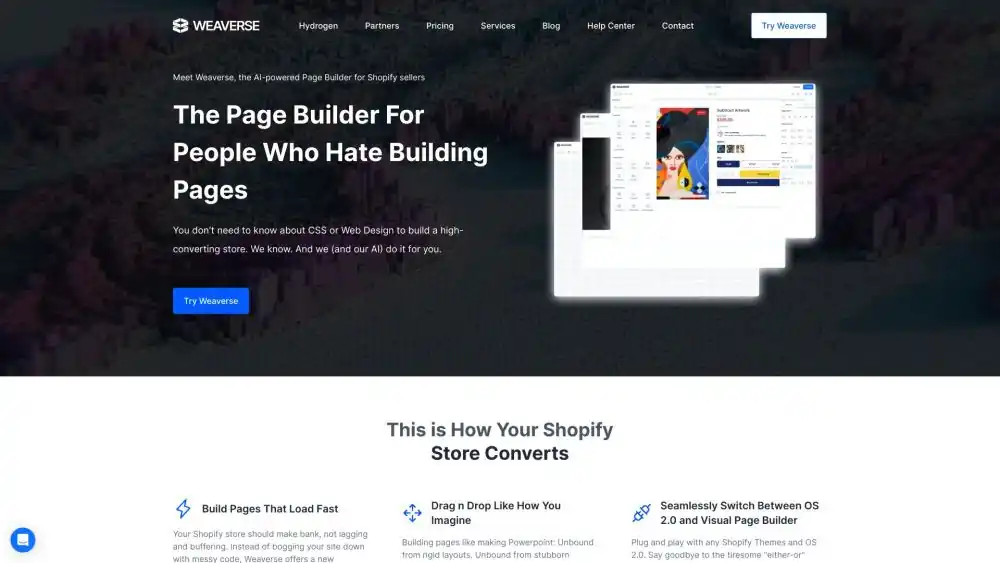Weaverse: A New Era of Collaborative Creation
Weaverse is a cutting-edge platform designed to revolutionize the way people collaborate and create together. It empowers users to seamlessly connect, share ideas, and build projects in a dynamic and intuitive environment. By breaking down traditional barriers to collaboration, Weaverse fosters innovation, creativity, and productivity.
At its core, Weaverse provides a robust foundation for teams and individuals to work together on a variety of projects, from creative endeavors to complex business initiatives. With features focused on real-time collaboration, project management, and content sharing, Weaverse aims to streamline workflows and enhance the overall collaborative experience.
Would you like to know more about specific features or use cases for Weaverse?
Weaverse: Pros and Cons
Pros
- Enhanced Collaboration: Real-time collaboration features can significantly improve team productivity and communication.
- Increased Creativity: By fostering a shared workspace, Weaverse can stimulate innovation and idea generation.
- Improved Project Management: Built-in project management tools can help streamline workflows and meet deadlines.
- Accessibility: The platform’s user-friendly interface can make it accessible to users with varying technical skills.
- Versatility: Weaverse can be adapted to a wide range of industries and project types.
Cons
- Dependency: Reliance on a single platform might create challenges if the service experiences downtime or changes.
- Data Security: Ensuring the protection of sensitive project information is crucial.
- Learning Curve: Users might need time to adjust to the platform’s interface and features.
- Cost: While some platforms offer free tiers, premium features or increased storage might incur additional costs.
- Potential for Overuse: Excessive reliance on collaboration tools can sometimes hinder individual focus and productivity.
Would you like to focus on a specific aspect of Weaverse, such as pricing, target audience, or specific features?
Weaverse Pricing: A Typical Model
Weaverse often employs a tiered pricing structure to cater to different user needs and budgets.
Common Pricing Tiers
- Free Tier:
- Designed for individuals and small teams.
- Offers basic collaboration features, limited storage, and project capacity.
- Ideal for experimenting with the platform.
- Basic Tier:
- Targets small to medium-sized teams.
- Includes enhanced features like increased storage, more project slots, and advanced collaboration tools.
- Often comes with a monthly or annual subscription fee.
- Professional Tier:
- For larger teams and enterprises.
- Provides comprehensive features, including advanced project management, security, and customization options.
- Typically priced on a per-user or per-project basis.
- Enterprise Tier:
- Tailored to large organizations with specific needs.
- Offers custom pricing and support, including dedicated account management and on-premise deployment options.
Additional Revenue Streams
- Premium Features: Some platforms might offer additional features as paid add-ons.
- Storage and Bandwidth: Users might be charged for exceeding storage or bandwidth limits.
- Integrations: Partnerships with other tools or services could generate revenue.
It’s important to note that pricing models can vary significantly between different Weaverse-like platforms. To get accurate pricing information, you’ll need to check the specific platform you’re interested in.
Would you like to explore other aspects of Weaverse, such as target audience or specific features?
FAQs about Weaverse
General Questions
- What is Weaverse?
- Weaverse is a collaborative platform that enables teams to work together on projects, share ideas, and manage workflows.
- Who can use Weaverse?
- Weaverse is designed for individuals, teams, and organizations across various industries.
- How does Weaverse differ from other collaboration tools?
- Weaverse often emphasizes real-time collaboration, visual interfaces, and a focus on project management, setting it apart from traditional document-sharing platforms.
Features and Functionality
- What kind of projects can I manage with Weaverse?
- Weaverse can be used for a variety of projects, including product development, marketing campaigns, software development, and creative projects.
- Can I invite external collaborators to my Weaverse project?
- Most Weaverse platforms allow you to invite external collaborators, often with different permission levels.
- Does Weaverse offer integration with other tools?
- Many Weaverse platforms integrate with popular productivity and communication tools like email, calendar, and project management software.
Pricing and Support
- Is Weaverse free to use?
- Some Weaverse platforms offer free tiers with limited features, while others require a subscription.
- What kind of support is available for Weaverse users?
- Support options typically include email, chat, or phone support, depending on the pricing tier.
Would you like to focus on a specific Weaverse platform or explore other aspects like security, data privacy, or mobile accessibility?
Conclusion: Weaverse – A Catalyst for Modern Collaboration
Weaverse represents a significant step forward in the evolution of collaborative tools. By offering a centralized hub for teams to connect, share ideas, and manage projects, it has the potential to transform the way work gets done.
The emphasis on real-time collaboration, visual interfaces, and integration capabilities sets Weaverse apart from traditional collaboration tools. However, it’s essential to evaluate the specific features, pricing, and security measures of each platform before making a decision.
As the digital landscape continues to evolve, Weaverse and similar platforms will likely play an increasingly crucial role in driving innovation, productivity, and team cohesion.
Would you like to explore specific use cases for Weaverse or discuss challenges in remote collaboration?
![]()






